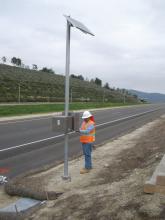Hybrid communications to variable message signs increase resilience to natural disasters and enable deployment in remote areas, as Alan Allegretto explains.
Variable Message Signs (VMSs) are a common sight and a well-proven means to improve public safety on our roads and highways. ITS professionals rank the
Ironically, however, current systems suffer from one critical weakness: communication to the signs often fails or is unavailable during emergencies – the time when the signs are most needed. Man-made or natural disasters regularly render cellular systems unusable due to system congestion or tower damage, which can sever the link between traffic management centres and the VMS network.
The backup to communication link failure - driving to a sign - is fraught with its own issues. These include the time taken to reach the sign (which may be inaccessible due to traffic or weather), diverting people and resources away from other critical tasks, and the safety of highway employees and the public while sign messages are being changed. The latter is tragically illustrated by the fact that of the 609 people killed in US work/construction zones in 2012, 130 of them were actually highway workers.
A small business based in San Diego, California, called 4ward Sciences has developed a system called Rapid Alert Network (RAN) designed to overcome the communications failures that can derail responses to emergencies and work zone management. RAN is a hybrid cellular/satellite communications system that controls and monitors VMSs. It has built-in redundancy for posting messages to VMSs by using dual-path, hybrid communications channels – either cellular phone circuits or the Iridium satellites. It offers reliability features and cost savings benefits that exceed those available from land-based fibre and copper wire solutions. With its 100% coverage of the Earth surface, it also serves areas that were previously unreachable (either because of location or cost). It can also be used to exploit the full potential of portable VMS by making temporary installations both easy and cost-effective.
Control can be accessed and operated from a traffic or emergency management centre, from any user-authorised computer or mobile device and from any site with internet access. Having logged in, the user can communicate with any sign anywhere in the world. Control sends the message via cellular communications provider or Iridium to the RAN hardware device, known as the ‘Runner’, which is mounted on each sign. Once the desired message is displayed the Runner sends a confirmation message back to Control. If no confirmations are received Control will automatically repeat the transmissions and will switch to the alternate communications channel if the primary method fails to respond.
Adding the Iridium service to a cellular-only solution provides two particularly pertinent features. First, Iridium is virtually immune to the catastrophes that trouble terrestrial systems (hurricanes, floods, blizzards, lightning strikes...) and secondly, tunnels aside, Iridium provides 100% coverage of an authority’s area of jurisdiction.
Iridium’s internal system redundancies ensure continuous communications to all signs, both stationary and portable. The hybrid architecture of the RAN system optimises the ‘cost/reliability/coverage’ equation: cellular systems provide inexpensive routine communications, while adding the auto-switch to satellite communications ensures immunity to disaster-related disruption. If the sign has any power supply (solar, batteries, emergency backup generators or landline) the signal will get through and the sign will display the required message.
On 11 September 2001, for instance, landline and cellular circuits were down in New York City and across the East Coast for days and weeks. Satellite circuits were the only option for assured, uninterrupted communications during and in the aftermath of the attack. During Superstorm Sandy and for several days thereafter, 25% of cellular sites in 158 counties across 10 states from Virginia to Massachusetts were out of service. Initial trials of the RAN showed it functioned flawlessly for the entire period.
Additional Benefits
Just as cellphones eliminated the need to install expensive landline voice infrastructure in many parts of the world, RAN with solar-powered stationary signs eliminates the need for costly and time-consuming trenching to provide communications and power to signs. Trenching is a major undertaking with costs dependent on many factors including the nature of the soil or rock, urban or rural location, existing interfering or obstructive infrastructure, environmental regulations, and rights of way.
In total, trenching installation costs for labour and materials can range from $17,000/km ($30,000 per mile) to several million dollars per mile, and DOTs are often required to make 50-year infrastructure support commitments. These complications make project planning itself very time-consuming and translates into installation and support costs that are hundreds, or even thousands, of times higher than those associated with RAN.
The elimination of trenching also reduces another significant issue - environmental impacts.
RAN is adaptable to support other ITS device types and broad families of other applications that require highly reliable and cost-effective communications. It enables a ‘transformative’ change in how DOTs and other transportation operators meet their ITS requirements. This transformation is almost certainly dictated by budgets that cannot keep pace with seemingly ever-growing occurrences of traffic-disrupting disasters or emergencies and their associated management requirements. By achieving orders of magnitude reductions in costs and time-to-implement, many important but previously-unaffordable projects become possible, and valuable tax revenue can be allocated to other pressing needs.
Field Tests
RAN and its Runner have completed field testing on signs in environments chosen specifically for their extreme climate conditions. In the Yukon, two Runners were installed last winter and have operated continuously on portable VMS. One of the VMS installations is used to provide timely advisory information about road conditions on a remote stretch of the Dempster Highway in central Yukon. Prior to installing RAN, communicating closures or advisories required driving 75km (46 miles) from the nearest highway maintenance camp to post a message on a barricade. RAN enables Yukon managers to post a closure or advisory on this VMS within minutes. A Runner also has been operating on a second Yukon VMS in Eagle Plains on the Arctic Circle. Both Yukon Runners have operated successfully through the harsh winter and have demonstrated Iridium’s capacity to provide immediate service to locations well beyond any cellular coverage. The Yukon is now considering the addition of Runners to portable VMSs for longer-term construction projects.
To demonstrate the performance and durability of a Runner in the opposite climate extreme - the hot highways of the Western US - a Runner was installed on an overhead VMS in Pharr, TX, a town 8km (5 miles) from the Mexican border. This Runner operated continuously through the hot summer and provided reliable communications utilising both the cellular and satellite networks.
So now transportation managers across the globe can combine cost-effective routine traveller information systems with assured communications during emergencies - when timely, accurate and potentially life-saving messages need to reach those in the path of danger.
• Alan Allegretto is executive advisor to 4ward Sciences and managing partner of GovScience Partners and a former Lieutenant Colonel in the USAF.









